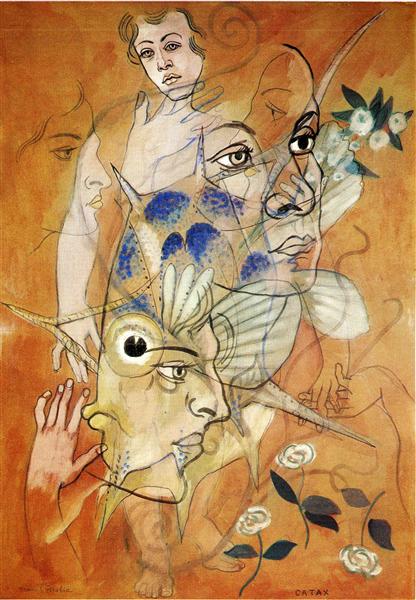Description
The work "Catax - 1929" by Francis Picabia is an intriguing piece that captures the essence of a deeply innovative creative period. In the fabric, we find a visual display that reflects the author's multifaceted approach, who is known for his ability to merge different styles and emotions into a single work. Picabia, a prominent representative of Dadaism and later of surrealism, presents in "Catax" an interlude that challenges the conventions of his time and causes a continuous reflection in the viewer.
At first glance, paint is characterized by its dynamic and enigmatic composition, where geometric shapes and bold color use of color are appreciated. The vibrant tones of red, yellow and blue are intertwined in a colorful dialogue that radiates vitality. Here, each hue seems to be in a contrast game, which produces a sense of movement and fluidity, elements that Picabia dominated in its artistic practice. This use of color, accompanied by an almost mechanical line, reflects the artist's fascination for technology and modernity, a recurring theme in his work given its context in the industrial era.
As for the characters, the painting evokes the presence of abstract and symbolic figures that, although they do not delineate in a traditional way, suggest a visual narrative. You can discern forms that allude to the human figure, but often stripped of its natural characteristics and presented in a state of transformation, reminiscent of the exploration of dadaism by deconstruction. The work, in this sense, reflects the search for Picabia for identity and representation in a world where the individual is constantly reconfigured by the social, political and technological context of his time.
A prominent aspect of the "catax" of 1929 is its ability to evoke different interpretations, remaining faithful to the essence of dadaism, which is characterized by its resistance to linear and logical sense. Picabia invites us to question not only the way we perceive art, but also the way we interact with the world around us. The ambiguity in the meaning of the work underlines one of the central philosophy of Dadaism: art as questioning and rebellion against established logic and order.
Francis Picabia was a pioneer who not only stood out for his influence on the Dadaist movement, but also continued to explore surrealism and modernism in the 1920s. His work "Catax" is at a time when art began to challenge the limits of the author and the spectator, and this clearly manifests itself in the expressive freedom of the painting. The rich intertextuality that is at work, together with the exploration of issues such as mechanization and alienation, place it as a precursor to contemporary conversations about the relationship between the human being and the machine.
In summary, "Catax - 1929" is a work that encapsulates the complexity of Picabian thought and reveals the multiple directions that art can take when facing the changing realities of the modern world. This painting not only invites aesthetic contemplation, but also challenges the viewer to reflect on their own relationship with art and context. The ability of Picabia to create a unique and provocative visual language even resonates today, positioning it as a key author in the history of the art of the twentieth century.
KUADROS ©, a famous paint on your wall.
Hand-made oil painting reproductions, with the quality of professional artists and the distinctive seal of KUADROS ©.
Art reproduction service with satisfaction guarantee. If you are not completely satisfied with the replica of your painting, we refund your money 100%.

